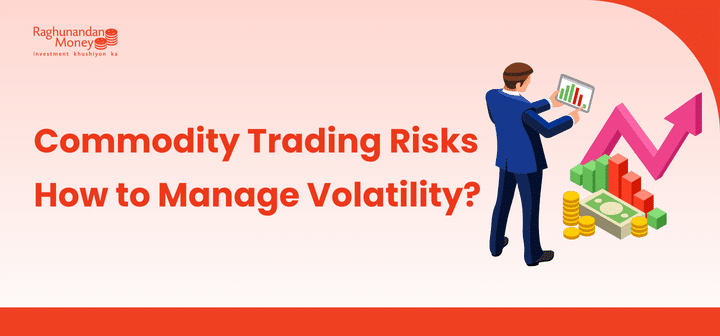Commodity Trading Risks – How to Manage Volatility?
Post Date : May 15, 2025

Disclaimer: Investments in the securities market are subject to market risks. This content is for educational purposes only and does not constitute financial advice.
Commodity trading involves buying and selling various commodities, ranging from crude oil and gold to industrial metals like copper. However, commodity markets are highly volatile, with price fluctuations leading to potential losses. These risks, collectively known as commodity trading risks, arise due to several factors affecting commodity values.
Managing these risks is essential for minimizing potential losses and maximizing profits. Effective risk management strategies can help traders navigate market volatility and make informed trading decisions.
Historical Example of Commodity Market Volatility
Commodity market crashes have caused significant financial turmoil in the past.
For instance, in 2015, major commodities like crude oil, copper, and iron ore witnessed sharp price drops. Crude oil prices fell below $40 per barrel, a level not seen since 2009. The Bloomberg Commodity Index also hit its lowest level since 1999 due to oversupply and weak demand for natural resources.
This example highlights how market volatility can erode value and shake investor confidence. Let’s explore the key risks associated with commodity trading.
Major Risks in Commodity Trading
1. Price Volatility Risk
Commodity prices are highly volatile due to supply-demand imbalances, economic conditions, and external events.
- Example: The 2020 crude oil price crash occurred when demand collapsed due to COVID-19 lockdowns, causing oil prices to fall to negative levels for the first time in history.
- Gold prices tend to rise during inflationary periods as investors seek safe- haven assets.
Sudden price swings can result in unexpected losses, particularly for traders who do not hedge their positions.
2. Market Risks
Commodity prices are affected by various global economic indicators, including:
- Recessionary periods that reduce demand for industrial metals.
- Oil price fluctuations caused by geopolitical instability.
These factors make market risks intrinsic to commodity trading.
3. Liquidity Risk
Liquidity risk arises when a commodity cannot be easily bought or sold, making it difficult for traders to exit positions quickly.
- Example: Rare metals like palladium may have lower liquidity than crude oil, making large transactions challenging.
4. Credit Risk
Credit risk occurs when one party in a commodity transaction fails to meet its obligations.
- Example: In futures contracts, if a counterparty defaults on a margin requirement, the other party incurs a loss.
5. Interest Rate & Currency Risk
Commodity prices are often denominated in U.S. dollars (USD), meaning that fluctuations in exchange rates impact commodity costs.
- A stronger USD makes commodities more expensive for foreign buyers, reducing demand.
- Higher interest rates increase borrowing costs, lowering speculative commodity demand.
- Example: If the Euro strengthens against the USD, oil becomes cheaper for European buyers.
6. Regulatory & Political Risk
Government policies, trade restrictions, and political instability can disrupt commodity markets.
- Example: India imposed restrictions on wheat exports in 2022, affecting global supply and prices.
- Geopolitical tensions (e.g., conflicts in oil-producing regions) can cause price spikes.
7. Weather & Natural Disasters Risk
Agricultural commodities like wheat, coffee, and sugar are highly sensitive to weather conditions.
- Example: Droughts in Russia have impacted wheat production, reducing supply and increasing prices.
8. Speculation & Leverage Risk
Excessive speculation can lead to market bubbles and crashes.
- Example: In 2008, crude oil prices soared to $147 per barrel due to speculative buying before the market crashed.
Leverage magnifies both profits and losses, making it a double-edged sword for traders.
Risk Management Strategies in Commodity Trading
1. Hedging with Futures & Options
Hedging is a common strategy to reduce risks.
- Futures contracts allow traders to lock in prices, reducing uncertainty.
- Options contracts provide downside protection in case of adverse price movements.
2. Diversification
Spreading investments across multiple commodities can help reduce overall risk exposure.
- Example: Investing in both gold (safe-haven asset) and crude oil (cyclical commodity) balances risk.
3. Stop-Loss Orders & Position Sizing
Setting stop-loss orders helps limit potential losses in volatile markets.
- Example: A stop-loss order can be placed to exit a crude oil trade if the price falls below $70 per barrel.
4. Analyzing Macroeconomic Indicators
Macroeconomic trends provide valuable insights into commodity price movements.
- Inflation tends to drive up gold prices.
- Higher interest rates may reduce commodity demand due to increased borrowing costs.
- GDP growth typically increases commodity demand.
5. Avoiding Overleveraging
Excessive leverage increases risk exposure.
- Example: A 10x leveraged crude oil trade could result in total account wipeout if prices move against the position.
- Use leverage cautiously and set risk limits.
Case Study: 2020 Crude Oil Crash
The COVID-19 pandemic triggered a severe commodity price crash, particularly in crude oil:
- Global lockdowns led to plummeting oil demand.
- Oversupply issues persisted as oil producers continued production.
- Price war between Russia and Saudi Arabia further flooded the market.
- Crude oil prices fell by 50% between January and March 2020.
On April 21, 2020, Brent crude prices closed at $9.12 per barrel, compared to $70 per barrel at the start of the year.
This crisis reinforced the importance of hedging strategies to minimize potential losses in extreme volatility.
Regulatory Framework for Managing Commodity Trading Risks
Several global regulatory bodies oversee commodity markets to ensure stability and prevent excessive speculation.
| Country |
Regulatory Body |
Key Regulations |
| USA |
CFTC (Commodity Futures Trading Commission) |
Futures trading regulations |
| India |
SEBI (Securities and Exchange Board of India) |
Regulation of MCX & NCDEX (Multi Commodity Exchange of India and National Commodity and
Derivatives Exchange) |
| UK |
FCA (Financial Conduct Authority) |
Commodity derivatives rules |
| Global |
IOSCO (International Organization of Securities Commissions) |
Risk management guidelines |
Conclusion
Understanding commodity trading risks is essential for anyone entering the market. By applying effective risk management strategies, traders can mitigate potential losses and improve decision-making.
Key takeaways:
- Monitor market conditions and macroeconomic indicators.
- Use hedging strategies like futures and options.
- Diversify investments across different commodities.
- Avoid excessive leverage and manage risk exposure wisely.
By staying informed and implementing risk control measures, traders can navigate commodity markets more confidently.
FAQs
1. What is the biggest risk in commodity trading?
Price volatility is the biggest risk, driven by supply-demand imbalances, geopolitical events, and macroeconomic factors.
2. How can traders reduce risks in commodity trading?
Traders can reduce risks by hedging, setting stop-loss orders, analyzing market trends, and diversifying investments.
3. Why do commodity prices fluctuate so much?
Commodity prices fluctuate due to natural disasters, geopolitical conflicts, inflation, and changing demand-supply conditions.
4. What is the role of hedging in commodity trading?
Hedging helps offset losses by locking in prices through futures contracts and reducing exposure to adverse price movements.
5. How does leverage increase risk in commodity trading?
Leverage amplifies both profits and losses, meaning small price movements can result in significant financial losses.
Need Help?
Contact RMoney at 0562-4266600 / 0562-7188900 or email us at
askus@rmoneyindia.com

Stock Trading Now trade in ₹9 Per Order or ₹ 999 Per Month Plans.
Future & Options Access F&O contracts with advanced tools for hedging and speculation.
Currency Trading Trade in major currency pairs and manage forex exposure efficiently.
Commodity Trading Diversify Trading with MCX & NCDEX by Trading in Gold, Silver, Base Metals, Energy, and Agri Products.
Margin Trading Funding Boost your buying power with upto 5X, Buy now Pay Later
Algo Trading Back test, Paper Trade your logic & Automate your strategies with low-latency APIs.
Trading View Leverage Trading View charts and indicators integrated into your trading platform.
Advanced Options Trading Execute multi-leg option strategies with precision and insights.
Stock Lending & Borrowing Earn passive income by lending stocks securely through SLB.
Foreign Portfolio Investment Enable NRIs and FPIs to invest in Indian markets with ease and compliance.
IPO Invest in upcoming IPOs online with real-time tracking and instant allotment updates.
Direct Mutual Funds 0% Commissions by investing in more than +3500 Direct Mutual Fund Scheme.
Corporate FDRs Earn fixed returns with low-risk investments in high-rated corporate fixed deposits.
Stocks SIPs Build long-term wealth with systematic investment plans in top-performing stocks.
Bonds & NCDs Access secure, fixed-income investments through government and corporate bond offerings.
Depository Services Safely hold and manage your securities with seamless Demat and DP services with CDSL.
Journey Tracing our growth and milestones over time.
Mission & Vision Guided by purpose, driven by long-term vision.
Why RMoney Platform Smart, reliable platform for all investors' needs.
Management Experienced leadership driving strategic financial excellence.
Credentials Certified expertise with trusted industry recognition.
Press Release Latest company news, updates, and announcements.
Testimonials Real client stories sharing their success journeys.
7 Reasons to Invest Top benefits that make investing with us smart.
SEBI Registered Research Trusted insights backed by SEBI-compliant research.
Our Technology Advanced tools enabling efficient online trading.
Calculators Access a suite of smart tools to plan trades, margins, and returns effectively.
Margin Calculator Instantly check margin requirements for intraday and delivery trades.
MTF Calculator Calculate MTF funding cost upfront to ensure full transparency before placing a trade.
Brokerage Calculator Know your exact brokerage charges before placing any trade.
Market Place Explore curated investment products and trading tools in one convenient hub.
RMoney Gyan Enhance your market knowledge with expert blogs, videos, and tutorials.
Performance Tracker Track our research performance with full transparency using our performance tracker.
Feedback Share your suggestions or concerns to help us improve your experience.
Downloads Access important forms, software, and documents in one place.
Locate Us Find the nearest RMoney branch or service center quickly.
Escalation Matrix Resolve issues faster with our structured support escalation process.
Back Office Log in to view trade reports, ledger, and portfolio statements anytime.
Account Modification Update personal or bank details linked to your trading account.
Fund Transfer Transfer funds instantly online with quick limit updation to your trading account.
Bank Details View our registered bank account details for seamless transactions by NEFT, RTGS or IMPS.
How to Apply IPO Step-by-step guide to apply for IPOs using your trading account.
RMoney Quick Mobile App Trade on-the-go with our all-in-one mobile trading app.
RMoney Quick login Quickly access your trading account through the RMoney Quick web-based trading.
RMoney Rocket Web Version Experience powerful web-based trading with advanced tools for algo traders.
RMoney Rocket Mobile Version Trade anytime, anywhere with our feature-rich mobile trading platform.













